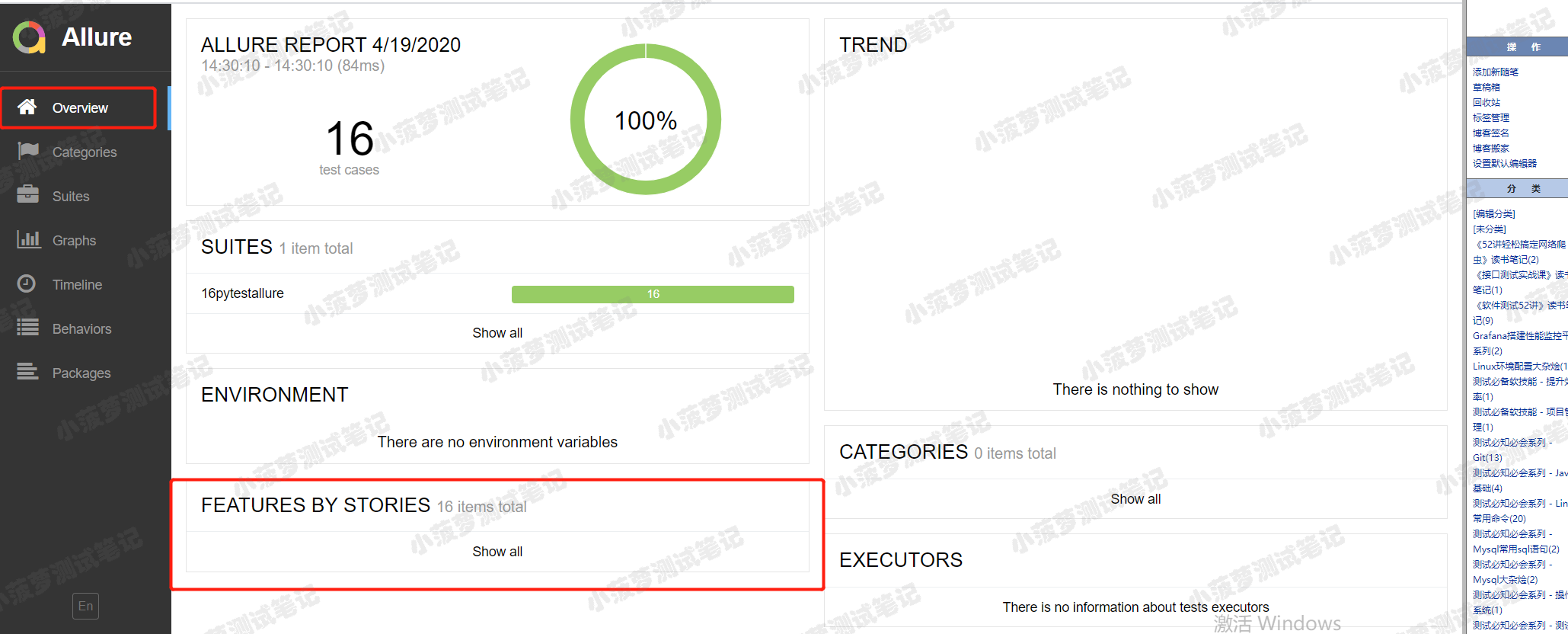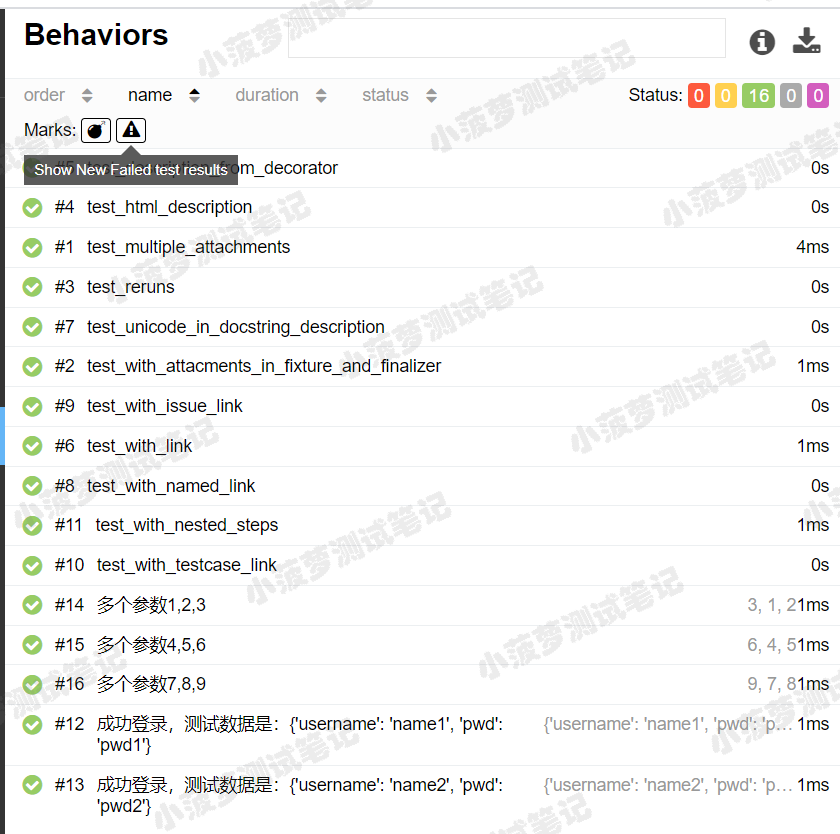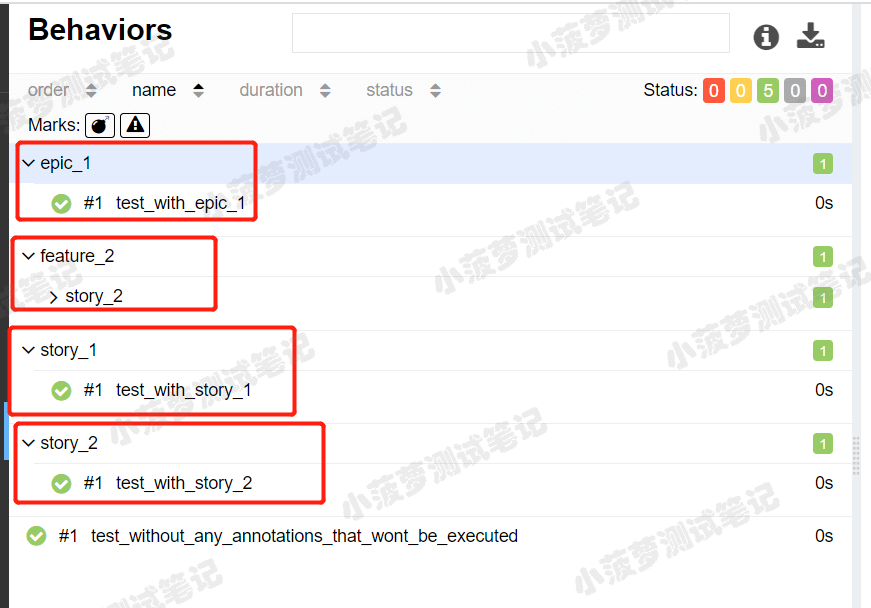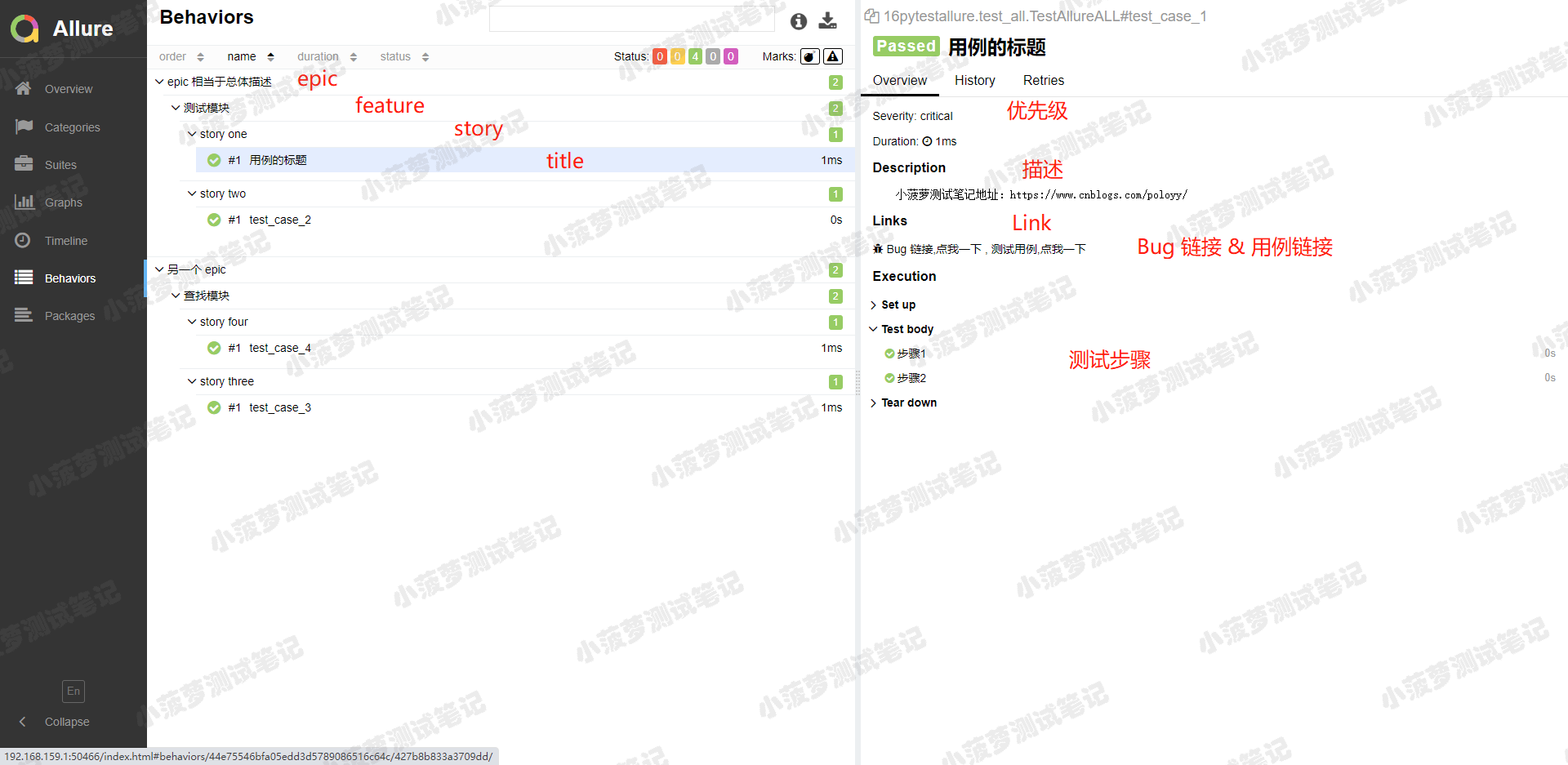1. 前言
- 前面几篇文章主要介绍了allure 的特性,这篇文章我们就来讲下 allure 的标记用法
- 有时候我们写 pytest 的时候,会用到 @pytest.mark 但并不会显示在 allure 报告上
- 而 allure 也提供了三种类型的标记装饰器,它们是可以显示在 allure 报告上的
2. allure的标记装饰器
- BDD 样式的标记装饰器
- 优先级(严重程度)标记装饰器
- 自定义标记装饰器
3. BDD标记装饰器
提供了三个装饰器
- @allure.epic:敏捷里面的概念,定义史诗,往下是 feature
- @allure.feature:功能点的描述,理解成模块往下是 story
- @allure.story:故事,往下是 title
4. 栗子一(story+feature)
4.1 测试代码
#!/usr/bin/env python# -*- coding: utf-8 -*-"""__title__ =__Time__ = 2020-04-19 14:27__Author__ = 小菠萝测试笔记__Blog__ = https://www.cnblogs.com/poloyy/"""import alluredef test_without_any_annotations_that_wont_be_executed():pass@allure.story('epic_1')def test_with_epic_1():pass@allure.story('story_1')def test_with_story_1():pass@allure.story('story_2')def test_with_story_2():pass@allure.feature('feature_2')@allure.story('story_2')def test_with_story_2_and_feature_2():pass
4.2 无标记装饰器
我们先看看没有设置标记装饰器时,allure报告是咋样的

4.3 添加装饰器
加了 @allure.feature 和 @allure.story 之后的 allure 报告

4.4 知识点
- story 是 feature 的子集,当测试用例有 @allure.feature、@allure.story 时,在报告上会先显示 feature,点开之后再显示 story【可以想象成,安徒生童话(feature)有很多个童话故事(story)】
- 如果不加 @allure.feature、@allure.story 时,在Behaviors栏目下,测试用例都不会分类显示,当用例多的时候可能看的花里胡哨
5. 栗子二
5.1 前言
这里应用了包括前面所讲的全部装饰器
5.2 测试代码
#!/usr/bin/env python# -*- coding: utf-8 -*-"""__title__ =__Time__ = 2020/10/27 19:44__Author__ = 小菠萝测试笔记__Blog__ = https://www.cnblogs.com/poloyy/"""import osimport allureimport pytest@pytest.fixture(scope="session")def login_fixture():print("=== 前置登录 ===")@allure.step("步骤1")def step_1():print("操作步骤---------------1")@allure.step("步骤2")def step_2():print("操作步骤---------------2")@allure.step("步骤3")def step_3():print("操作步骤---------------3")@allure.epic("epic 相当于总体描述")@allure.feature("测试模块")class TestAllureALL:@allure.testcase("https://www.cnblogs.com/poloyy/", '测试用例,点我一下')@allure.issue("https://www.cnblogs.com/poloyy/p/12219145.html", 'Bug 链接,点我一下')@allure.title("用例的标题")@allure.story("story one")@allure.severity("critical")def test_case_1(self, login_fixture):"""小菠萝测试笔记地址:https://www.cnblogs.com/poloyy/"""print("测试用例1")step_1()step_2()@allure.story("story two")def test_case_2(self, login_fixture):print("测试用例2")step_1()step_3()@allure.epic("另一个 epic")@allure.feature("查找模块")class TestAllureALL2:@allure.story("story three")def test_case_3(self, login_fixture):print("测试用例3")step_1()@allure.story("story four")def test_case_4(self, login_fixture):print("测试用例4")step_3()if __name__ == '__main__':pytest.main(['-s', '-q', '--alluredir', './allure'])os.system('allure generate -c -o ./allure-report')os.system('allure open ./allure-report')
5.3 allure 报告


6. 总结
倘若是用 pytest+allure 写项目,又想用 @pytest.mark.xxx 来给不同的用例添加标记的话,可以尝试用 @allure.feature、@allure.story 替换,毕竟可以显示在报告上
6.1 提出问题
用命令行方式运行时,可以指定运行某个 story、feature、epic吗?
6.2 自问自答
当然可以,跟 @pytest.mark.xxx 指定标签运行的方式没啥区别,添加下面的命令行参数就行
- —allure-epics
- —allure-features
- —allure-stories
6.3 举栗子
# 只运行 epic 名为 test 的测试用例pytest --alluredir ./report/allure --allure-epics=test# 只运行 feature 名为 模块 的测试用例pytest --alluredir ./report/allure --allure-features=模块# 只运行 story1、story2 的测试用例(也可以不用=号 空格就行了哦)pytest tests.py --allure-stories story1,story2# 指定 feature+storypytest tests.py --allure-features feature2 --allure-stories story2

